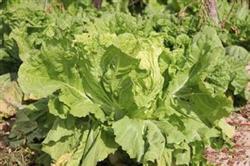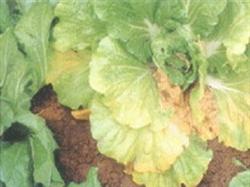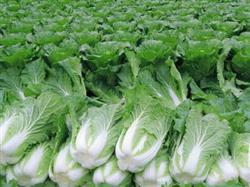Technical measures for Disease Control of Chinese Cabbage

Downy mildew, virus disease, soft rot and dry burning heart disease are the main diseases of Chinese cabbage. The main results are as follows: 1. Downy mildew can occur from seedling stage to pericardial stage, mainly harming Chinese cabbage leaves. At first, the disease begins from the lower leaves, and water-immersed, yellowish polyhedral disease spots are produced on the leaves, and gradually expand and become yellowish brown. In severe cases, the leaves are dry and inedible. The severity of the disease is closely related to climate, varieties and cultivation techniques, with more rainfall in autumn and relative humidity higher than 70%, which is conducive to the occurrence of downy mildew; sowing too early, too high density, partial application of nitrogen fertilizer, and poor drainage in the field. Prevention and control measures: (1) agricultural prevention and control: first, reasonable close planting, planting 2500-3000 plants per mu for middle and early-maturing varieties and 2000-2400 plants per mu for late-maturing varieties; second, balanced fertilization, topdressing multi-element compound fertilizer to avoid partial application of nitrogen fertilizer; third, timely drainage after rain to control stagnant water in the field. (2) Chemical control, 40% ethyl phosphate aluminum 800 times solution, 58% metalaxyl manganese zinc solution or 1.5% cream bingwei 1000 times solution can be used in the initial stage of the disease; Shuang Ke or 72% DuPont Klu 800x solution can be used for foliar spray, once a week, 3 times in a row. 2. Virus disease: symptoms can be divided into two types: one is mosaic type: leaves produce uneven green mottled or mosaic leaves; the other is wrinkled type: heart leaves show wrinkled deformities, hard and brittle. The occurrence of the disease is related to climate, management and other factors. After sowing, Chinese cabbage encountered high temperature and drought, root growth and development was inhibited, disease resistance decreased, coupled with high temperature and drought conducive to the occurrence of aphids, high virus transmission rate, serious virus disease. In addition, extensive management, lack of water and fertilizer are serious. Control measures: Chinese cabbage virus disease is transmitted by aphids, so it is very important to control aphids. 2000 times of imidacloprid can be sprayed every 7-10 days for 2-3 times. After the cabbage is infected, spray 1.5% Zhiyanling No. 2 800x liquid or virus nemesis, Kangrun No. 1 1000 times liquid foliar spray, once a week, even prevention 2-3 times. 3. Soft rot: from rosette stage to pericardium stage, there are often two types: one is Yanyan type: Chinese cabbage wilts at noon on a sunny day, recovers sooner or later, and the whole plant dies after several days; second, soft rot type: the petiole or leaf ball of damaged Chinese cabbage shows sticky soft rot and gives off a bad smell. The severity of the disease is related to climate, stubble and sowing date, such as heavy rainfall, stagnant water on the surface, and early sowing and continuous cropping. Prevention and control measures: (1) Agricultural control: avoid continuous cropping, prevent stagnant water on the ground, remove diseased plants in time, take them out of the field for destruction, and prevent transmission. (2) Chemical control: 72% agricultural streptomycin 3000-fold solution, 3% Kejokang 1000-fold solution and 20% Longke bacteria 1000-fold solution can be sprayed alternately, once a week, 2-3 times. 4. Dry burning heart disease generally occurs in the rosette stage of Chinese cabbage, the young leaves show dry edges, and the symptoms are obvious in the heading stage, the upper part of the leaves gradually become dry and yellowing, the mesophyll is dry paper-like, the leaf veins are yellow-brown to dark black, and the disease site is mainly in the middle of the leaf ball. The disease is a physiological disease, which is mainly caused by the lack of calcium and manganese. Prevention and control measures: (1) increase the application of organic fertilizer. (2) Chemical control: 0.7% manganese sulfate plus green Fenwei No. 3 was sprayed before the seedling stage, rosette stage or pericardium stage of Chinese cabbage.
- Prev

Control measures of yellow leaf disease (shedding disease) of Chinese cabbage
Chinese cabbage yellow leaf disease is a general term for fungal yellow leaf disease of Chinese cabbage. Chinese cabbage, yellow bud white and other Chinese cabbage, pakchoi and yellow leaf disease occur from north to south. The disease occurred in the seedling stage. The harmful fungus mustard is Fusarium oxysporum, which belongs to the subphylum of semisciferous bacteria. The disease can be sprayed or in the field.
- Next

The effect of topdressing Chinese cabbage is good according to the growing period.
Chinese cabbage has a high yield and needs a large amount of fertilizer. On the basis of applying sufficient base fertilizer, don't worry about topdressing. Topdressing should be determined according to different growth periods and seedling conditions. There is no topdressing in the seedling stage. If the bottom fertilizer is insufficient, you can apply 10 kg ammonium sulfate per mu at the stage of 3 to 4 true leaves for the first time, sprinkle it on both sides of the seedling and water it immediately.
Related
- Where is it suitable to grow horseradish in China? it is expected to see the middle altitude horseradish in Alishan.
- How to prevent tomato virus disease reasonably? (Control methods included)
- Many people like to plant towel gourd on the balcony. What are the main points of this method and management?
- What crops can chili peppers be mixed with?
- Fertilization techniques and matters needing attention in Tomato
- What are the grafting techniques for peach seedlings in spring?
- Harm and control methods of root swelling disease of Chinese cabbage
- What are the pests of sweet potatoes? How to prevent and cure it?
- Symptoms, causes and Control methods of navel Rot in Tomato
- The cause of "Cucumber rotten bibcock" in Farmers' planting Cucumber and its Control Plan

